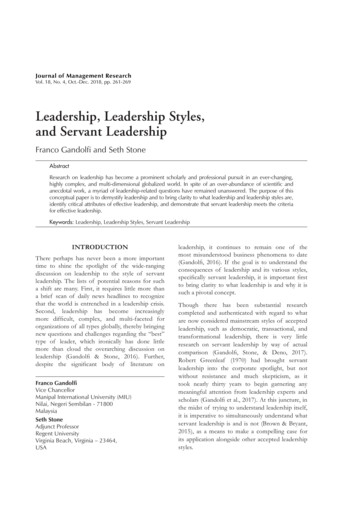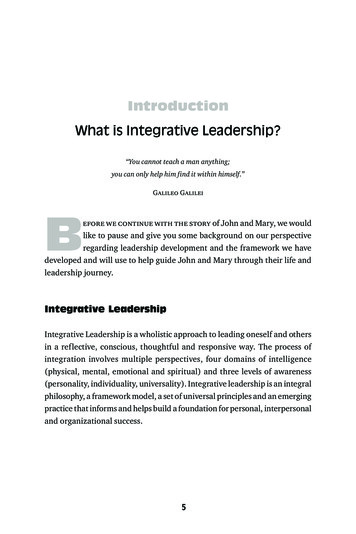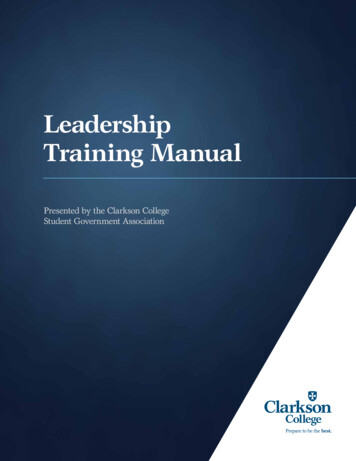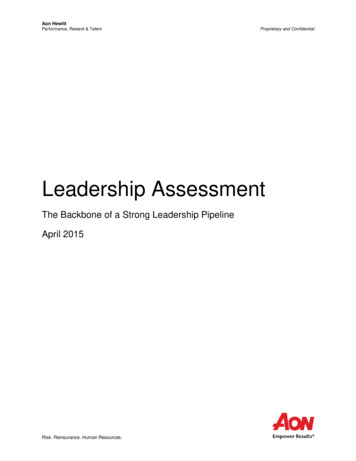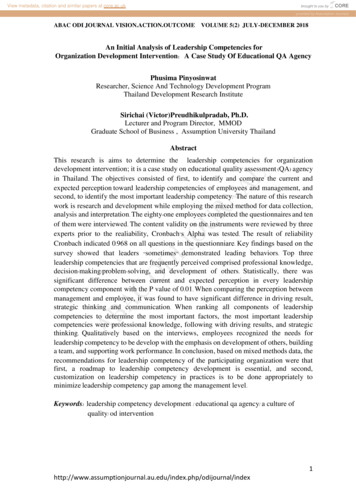
Transcription
View metadata, citation and similar papers at core.ac.ukbrought to you byCOREprovided by Assumption JournalsABAC ODI JOURNAL VISION.ACTION.OUTCOMEVOLUME 5(2) JULY-DECEMBER 2018An Initial Analysis of Leadership Competencies forOrganization Development Intervention: A Case Study Of Educational QA AgencyPhusima PinyosinwatResearcher, Science And Technology Development ProgramThailand Development Research InstituteSirichai (Victor)Preudhikulpradab, Ph.D.Lecturer and Program Director, MMODGraduate School of Business , Assumption University ThailandAbstractThis research is aims to determine the leadership competencies for organizationdevelopment intervention; it is a case study on educational quality assessment (QA) agencyin Thailand. The objectives consisted of first, to identify and compare the current andexpected perception toward leadership competencies of employees and management, andsecond, to identify the most important leadership competency. The nature of this researchwork is research and development while employing the mixed method for data collection,analysis and interpretation. The eighty-one employees completed the questionnaires and tenof them were interviewed. The content validity on the instruments were reviewed by threeexperts prior to the realiability, Cronbach’s Alpha was tested. The result of reliabilityCronbach indicated 0.968 on all questions in the questionniare. Key findings based on thesurvey showed that leaders “sometimes” demonstrated leading behaviors. Top threeleadership competencies that are frequently perceived comprised professional knowledge,decision-making/problem-solving, and development of others. Statistically, there wassignificant difference between current and expected perception in every leadershipcompetency component with the P value of 0.01. When comparing the perception betweenmanagement and employee, it was found to have significant difference in driving result,strategic thinking and communication. When ranking all components of leadershipcompetencies to determine the most important factors, the most important leadershipcompetencies were professional knowledge, following with driving results, and strategicthinking. Qualitatively based on the interviews, employees recognized the needs forleadership competency to be develop with the emphasis on development of others, buildinga team, and supporting work performance. In conclusion, based on mixed methods data, therecommendations for leadership competency of the participating organization were thatfirst, a roadmap to leadership competency development is essential, and second,customization on leadership competency in practices is to be done appropriately tominimize leadership competency gap among the management level.Keywords: leadership competency development / educational qa agency/ a culture ofquality/ od ndex.php/odijournal/index
ABAC ODI JOURNAL VISION.ACTION.OUTCOMEVOLUME 5(2) JULY-DECEMBER 2018IntroductionThe development of leadership competencies is an essential part of the organizations,leaders and managers in particular. The leader is the key person who leads employees to reachhigh level-performance while increasing organizational effectiveness. Regardless of private orpublic organization, each has its own expectations. Nonetheless, each has common ideas thatleadership behavior play an important role in shaping organizational working atmosphere, aculture, and climate.Considering the context of an education quality assurance (QA) agency both domestic andinternational arena, QA agency is set as a public organization, thus the agencies tend to workindependently and not being controlled by any particular government. The role is to ensurequality of education institute's operation and quality of graduates to be able to fulfill demands oflabor market (Santiago et al., 2008). For example, Council for Higher Education Accreditation(CHEA), USA., which is the pioneer of education quality assurance agency, plays the rols ofassuring the quality of higher education in the U.S.;it also forms a quality group for QAworldwide called CHEA International Quality Group in 2012. The main goal is to providemembers with an opportunity to learn and share their best practices and improve innovation forquality assurance.Rosenbaum (2003) of African public management articulated that leadership competencyin public sector is an essential part of the organization and it equips leaders with the ability todeal with challenges while improving the effectiveness of the organization activities. First,leaders should be able to convey complex ideas in oral and writing forms for complex publicissues, while demonstrating the need of accountability and accommodating the expectation ofvarious stakeholders. Secondly, leaders must learn to adapt rapidly to change, especially socialissues, political circumstances, international collaboration and public-private partnership inaddition to, responding to complex issues and challenges critically and creatively. Third, leadersin the public sector should foster effective collaboration and engage with both within and outsidethe organizations, while ensuring team-building. Fourth, leaders must recognize the importance ofgood governance, ethical awareness and sensitivity, and avoid conflict of interest, power andauthority. Fifth, entrepreneurialism and risk-taking ability is vital for public organizations, namelyimprovement and change of internal work processes for effectiveness. Organizational leadersshould be aware of vulnerable conditions and be able to strategize while grasping newopportunities for development. Sixth, strategic planning is necessary for translating clients’ orstakeholders’ needs to short and long-term plans for sustainable growth. Lastly, ability to php/odijournal/index
ABAC ODI JOURNAL VISION.ACTION.OUTCOMEVOLUME 5(2) JULY-DECEMBER 2018harmonious multi-nation, multicultural environment to cope with international collaborationwhereby the connectivity among nations help improve society at large.Such ideal ledership character is a common expectation for public organization at alllevels, while aiming its goal at improving organization effectiveness by leveraging collectiveculture. By means of improving organization effective literally interplay with the ability of theleader to lead how to lead in public QA sector; and thus clear mission and purpose, organizationcultures, customer, and system are the ideals for accomplishment.According to a recent CEB survey of employees in Asia, Adam (2013) revealed that only17% of respondents are certain that their organization leaders are competent. The root cause ofleadership gap is a lack of leadership experience and skills of Asian leaders. The cause is that therapid growth of Asian economy is greater than a growth of Asian leaders (Adam, 2013).Another challenge for the Asian leader is that the Asian culture hinders leadershipdeployment. Confucianism, one of the acceptant beliefs among Asian countries, values stabilitymore than change and does not provide much supports of idea expression for the followers(Noronha, 2002). On the other hand, Confucianism is also perceived as a culture of qualitybuilder, which refers to a charismatic leadership with goodness, kindness, and ethics. Therefore,it is likely to shape employees’ perception toward their leader that they might have to follow theirleader without exception. By this, a leader has to play both active and passive roles in order todrive a team dynamic and make use of informal relationship of a leader and followers, especiallythe vertical connection like father-son, to increase employee effectiveness.Adam (2013) presented that the Asian needs the essential leadership competencies forhigh performing organization fulfilling the leadership capacity of team building, developingpeople, strategic thinking, enterprise vision, and problem solving. Adam (2013) also mentionedthe needs for leadership development for Asian countris for specific areas, which are:1) The development of the next generation of leaders through team-building and developingothers: A leader has to play the role of trainer and learner in the participative trainingenvironment.2) The issues of strategic and global situations to operational leadership by boosting thestrategic thinking skill and enterprise vision: A leader should focus on both internal andexternal directions affecting the effectiveness of an organization.3) The improvement of organization and employee performance through an analytical anddecision making hp/odijournal/index
ABAC ODI JOURNAL VISION.ACTION.OUTCOMEVOLUME 5(2) JULY-DECEMBER 2018While considering the Thai context, Thai organizations are likely to believe that beinghigh-performing organization have to embed the quality concept in the organizations. In 1975,the concepts of Deming and Juran was firstly introduced to Thai companies (Chan & Quazi,2002). Many quality concepts, such as Thailand Quality Awards (TQA) and ISO 9000, areemployed until now. Although many quality concepts are widely accepted among Thai leaders,the awareness of Thai people about quality does not consistentl demonstrate. An unavoidablefactor is the value of Thai society as a homogenous society. Though key practices from Westcountries such as competency and knowledge management is make known to Thai public andprivate organizations, few understand the differences between Western and Thai practices whenit comes to the real practices to better fit with Thai culture (Pimpa, 2012).According to Thai culture dimensions of Hofstede’s analysis, a low level of individualismis clearly shown in Thai society. On the contrary, Thai is likely to be one of the highestcollectivistic groups. Hofstede (as cited in Pimpa, (2012) elaborating that collectivist society tendsto foster strong relationships in which member takes responsibility for others. Such influence,Thai people tend to accept things as the way they are and avoid confrontation. The commoncharacter of Kreng-jai is an example that discourages personality hindering active and proactivebehaviors (Laohavichien et al., 2011). Kreng-jai is defined as to take the other’s feelings intoaccount and be considerate to other people. Such characteristics potentially weakens quality andthe maturity of quality practices among Thai companies. Thailand was at the bottom three ofAsian countries when it comes to the application of ISO quality management (Chan & Quazi,2002).This challenge becomes the top issue for Thai organization because its solution is to havea charismatic leader leading for a proactive process, for better quality practices and for excellentperformance. Promtan et.al. (2016) also identified the need of leadership competency developmentas the organization’s priority. The leadership competencies in the Thai context is divided intofour components (Promtan et.al., 2016):1. Leading the Organization: Change Management, Problems Solving and DecisionMaking, Vision and Strategic Thinking, Creativity and Innovation, TaskManagement, and Organizational Knowledge2. Leading the Self and Others: Adaptability, Listening & Understanding & Feedback,Effective Communication, Building and Retaining Talent, and Coaching andDeveloping Others3. Leading for Results and Ethics: Ethics and Integrity, and Drives for Results4. Self-Development: Continual .php/odijournal/index
ABAC ODI JOURNAL VISION.ACTION.OUTCOMEVOLUME 5(2) JULY-DECEMBER 2018From the view of education sector, educational institutions are encouraged to foster aculture of quality for the productivity of education while embracing quality assurance system asthe framework for planning, decision and execution. A culture of quality based on a participatoryand systematic orientation is defined as level of 3, which literally indicated that educationalinstitution place the emphases on goal, context, and stakeholder needs (Pornrungroj, 2014).Education leadership relates to all levels; it is a role model that supports educators and learners tostrive for excellence, and maintain good relationship with external stakeholders.That concept is also utilized in the educational QA agency of Thailand, namel, processingthe external quality assessment and encouraging institutions to provide the qualified educationservice to learners. The values of the education QA agency are to overcome all possiblelimitations, nurture creativity, enhance ethics, develop a sense of social responsibility, andimprove quality awareness. (ONESQA, 2015).Currently, the new strategy for the education QA agency has been approved by its Boardof Committee with four focuses: innovation, excellence, recognition, and sustainability(ONESQA, 2018), while alignment with Thailand 4.0 as the national long-term strategy(Maesincee, 2016). The educational reformation plan of National Reform Steering Assembly in2016 has been taked place, requiring the QA agency to be ready for change. Use of innovation ismain practice for management and working process for productivity. Excellence is concernedgood governance and recognition among other QA agencies to ensure the needs of thestakeholders. Lastly, sustainability in terms of its people and external assessors relates tocompetency development and active engagement of both internal and external customers.Current situationThe SWOT and SOAR analysis integrated with Mckinsey 7S Framework was used toidentify and analyze the current situation of the participating QA agency. Regarding the analysis,the strongest and most impactful element accelerating organization performance to achieve itsgoals is “styles”, which refers to the leading and working styles. Due to the contradiction betweenthe organization system and leading sytle, leaders from the government agencies tends to bringtheir beaucratic leading style to the QA agency, where requires autonomy as the third party ofthe education sector. Even though the QA agency has a strong and sound strategy, its system,structure, and style become huge obstacles to achieve the goals. Among these elements, leadingsytle is the most important element that should be focus for further improvement because style isthe main element which is able to align other organization elements to be php/odijournal/index
ABAC ODI JOURNAL VISION.ACTION.OUTCOMEVOLUME 5(2) JULY-DECEMBER 2018Statement of the ProblemAccording to SWOT and SOAR initial analysis, “style” is rated as the top priority that theeducation QA agency has to pay deep attention for improvement. Due to a common leading stylewith a hierarchical organization, management leads with controlling rather than facilitating,which is the obstacle to increase organization effectiveness. According to this situation,development of leadership for leaders is very critical and required to proceed at this time.Another discovery from SWOT/SOAR analysi was that, there was not a set of leadershipcompetencies for leaders in an education QA field. With the reasons mentioned, this researchaims to identify the important leadership competencies and how leadership competencydevelopment program could be suggested for this current time, utilizing feedback frommanagement and employees through structured questionnaire and interviews.Research Objectives1. To identify the current perception toward leadership competencies for a culture of quality.2. To compare the employees’ perception between the current and expected experiences ofleadership competencies for a culture of quality.3. To compare the employee and management perceptions toward leadership competenciesfor a culture of quality.4. To identify the most important leadership competency for a culture of quality.Research HypothesisH1: There is a difference in the employees’ perception between the current experience and animportance of leadership competencies for a culture of quality.Current Perception of Leading Self ClusterH2a: There is a difference in employee and management current perception toward takeinitiative competency.H2b: There is a difference in employee and management current perception toward planningand organizing competency.H2c: There is a difference in employee and management current perception toward agilelearner/self-development competency.H2d: There is a difference in employee and management current perception towardcommunication dex.php/odijournal/index
ABAC ODI JOURNAL VISION.ACTION.OUTCOMEVOLUME 5(2) JULY-DECEMBER 2018H2e: There is a difference in employee and management current perception toward adaptabilitycompetency.H2f: There is a difference in employee and management current perception toward professionalknowledge competency.Current Perception of Leading Others ClusterH3a: There is a difference in employee and management current perception toward decisionmaking/problem solving competency.H3b: There is a difference in employee and management current perception towarddevelopment of others competency.H3c: There is a difference in employee and management current perception toward supportwork performance competency.H3d: There is a difference in employee and management current perception toward building ateam competency.H3e: There is a difference in employee and management current perception toward valuediversity competency.H3f: There is a difference in employee and management current perception toward conflictmanagement competency.Current Perception of Leading the Organization ClusterH4a: There is a difference in employee and management current perception toward creating avision competency.H4b: There is a difference in employee and management current perception toward act withintegrity/accountability competency.H4c: There is a difference in employee and management current perception toward strategicthinking competency.H4d: There is a difference in employee and management current perception toward innovationcompetency.H4e: There is a difference in employee and management current perception toward systemthinking competency.H4f: There is a difference in employee and management current perception toward drivingresult dex.php/odijournal/index
ABAC ODI JOURNAL VISION.ACTION.OUTCOMEVOLUME 5(2) JULY-DECEMBER 2018Expected Perception of Leading Self ClusterH5a: There is a difference in employee and management expected perception toward takeinitiative competency.H5b: There is a difference in employee and management expected perception toward planningand organizing competency.H5c: There is a difference in employee and management expected perception toward agilelearner/self-development competencyH5d: There is a difference in employee and management expected perception towardcommunication competency.H5e: There is a difference in employee and management expected perception towardadaptability competency.H5f: There is a difference in employee and management expected perception towardprofessional knowledge competency.Expected Perception of Leading Others ClusterH6a: There is a difference in employee and management expected perception toward decisionmaking/problem solving competency.H6b: There is a difference in employee and management expected perception towarddevelopment of others competency.H6c: There is a difference in employee and management expected perception toward supportwork performance competency.H6d: There is a difference in employee and management expected perception toward buildinga team competency.H6e: There is a difference in employee and management expected perception toward valuediversity competency.H6f: There is a difference in employee and management expected perception toward conflictmanagement competency.Expected Perception of Leading the Organization ClusterH7a: There is a difference in employee and management expected perception toward creatinga vision competency.H7b: There is a difference in employee and management expected perception toward act withintegrity/accountability dex.php/odijournal/index
ABAC ODI JOURNAL VISION.ACTION.OUTCOMEVOLUME 5(2) JULY-DECEMBER 2018H7c: There is a difference in employee and management expected perception toward strategicthinking competency.H7d: There is a difference in employee and management expected perception towardinnovation competency.H7e: There is a difference in employee and management expected perception toward systemthinking competency.H7f: There is a difference in employee and management expected perception toward drivingresults competency.Definition of terms1. Leadership competencies refer to the process and individual person to be able to employknowledge, skill, and abilities to lead self, others, and an organization to achieve itsgoals. There are eighteen competencies in this study, six competencies per each leadinglevel.2. A culture of quality is a set of culture that delights customers’ satisfaction and focuses onthe quality improvement for organization excellence.Scope of the StudyThe study focused on core competencies of leadership of education QA agency. The totalrespondents in this study are n 81. Two research instruments have been utilized, consisting of thestructured questionnaire and interview checklists. The research was undertaken eight months,ranging from literature review and an initial analysis, questionnaire construction process, validityand reliability test, questionnaire distribution, data analysis, data interpretation and formulationof recommendations.Literature Review and Conceptual FrameworkTransformational LeadershipThe concept of transformational leadership is a process of leaders and followers helpeach other to enhance a higher level of motivation, moral, and performance based onmechanisms. Northouse (2016) added to Burn’s concept that transformational leaders are able toinfluences followers to complete more than expectations and beyond mentality. Demingconsidered the transformational leadership is necessary for shaping a culture of quality (Dean andBowen, 1994). This type of leader leads their followers by engagement, intrinsic need focus, andconsciousness raising (Hay, 2012), which can foster a continual improvement and team php/odijournal/index
ABAC ODI JOURNAL VISION.ACTION.OUTCOMEVOLUME 5(2) JULY-DECEMBER 2018environment. The concept of transformational leader is comprised of 4 elements:1. Idealized Influence: A leader provides a role model of high ethical behavior, foster prideand trust among followers. Together with trust, it is important to include integrity inorder to ensure that followers are strongly convinced (Northouse, 2016).2. Individualized Consideration: A leader as a coach or mentor provides followers with anysupports for work accomplishment (Hall et al., 2005). More importantly, a leader needsto listen effectively in order to understand followers’ needs and respect each individualcontribution.3. Inspirational Motivation: A leader inspires followers to commit to vision and worktowards goals. Therefore, a sense of purpose should be fostered among followers.Purpose and meaning will be the key driver, which a leader uses, for team success.4. Intellectual Stimulation: A leader has to innovatively unlock team’s creativity andsupport a team to challenge status quo (Desbrow, 2016). To encourage followers to takerisks and work on their assumption will develop them to think independently. Learningfrom such situations is valued as the opportunity for development.Quality PerceptionFrederick W. Taylor (as cited in PP&S, 2016) introduced the Principles of ScientificManagement by using statistical theory to come up with a productivity improvement approach inmanufacturing sector such as functional specialization, time and motion process analysis, andquality control by a final product inspection. Dr. W. Edwards Deming, an ASQ Honorary memberin 1970, developed the PDSA (plan, do, study, and act) cycle from the basis of ShewhartLearning Improvement Cycle, which relates to quality for an entire process of an organization,until experimenting to implementation and for continual improvement with "Deming's FourteenPoints of Quality"- a management philosophy (The W. Edwards Deming Institute, 2016). Most ofquality problems were under control of management, therefore, management should emphasizeon cultural change and cooperation of employees as the keys for an organization to reach itsexpectation of quality. Other quality practices as Lean Manufacturing or Lean Thinking, TotalQuality Management, were promoted by as a methodology of workflow improvement forperformance betterment (ASQ, 2018).At this day, quality becomes one of the aspects of organizational cultures that supportsthe constant fulfillment for customer satisfaction through an entire system of an organizationsuch as tools, techniques, services, and trainings (Malhi, 2013). Thus, an organization has aneffort to merge quality to its culture by actualizing the quality management tool to its workinghabit and system, including management philosophy, lifestyle, and x.php/odijournal/index
ABAC ODI JOURNAL VISION.ACTION.OUTCOMEVOLUME 5(2) JULY-DECEMBER 2018Management and a Culture of QualitySrinivasan and Kurey (2014) explained in Harvard Business Review that the fouressentials of quality are 1) leadership emphasis, 2) message credibility, 3) peer involvement, and4) employee ownership. Safty (2012) stated that a culture of quality begins with leadershipbelieving in the implications of the systems for serving customers’ needs. The importance ofleadership is the most necessary element to use for communicating about quality and creatingemployees’ involvement and their sense of belonging to the organization. It is also the biggestconcern that leaders should pay serious attentions because often time, gaps between theirmessages and their actions still exist. Executive participation becomes the most essential factordriving quality work culture through leaders showing enthusiasm and commitment.Transformational Leadership CompetencyAll leadership theories mention common leader’s behaviors, actions, and charactersregarding the abilities to adapt, effective interpersonal communication and relationship, and gooddecision-making, although they are applied differently (Das , Kumar and Kumar, 2011). Aleadership competency framework is an appropriate tool to understand behaviors, actions,andleadership characters systematically.According to the Center for Creative Leadership (CCL, 2015), CCL’s researchers believethat everyone can learn and develop their leadership behavior by beginning with understand selfto lead self; understand others to lead others; and understand change to lead change. The threeleading model (figure 1) is interdependent and flexible (Center for Creative Leadership, 2015), soit can provide an individual with multiple starting points and opportunities to learn theconnection of each component.Figure 1: Youth Leadership Development ex.php/odijournal/index
ABAC ODI JOURNAL VISION.ACTION.OUTCOMEVOLUME 5(2) JULY-DECEMBER 2018The concept of competencies is dependent on challenges occurring by chance for eachlevel in the organization. To begin with self, leading self’s challenges are to prepare formanagement and leadership role and to improve personal effectiveness and performance. Leadingother’s challenges is to build relationship to accomplish goals, to deal with conflict, and moreimportantly to shift from a soloist to a team player who can support and lead a team. Leading theorganization’s challenges is to set directions for an organization, promote an alignment for awhole organization, and ensure commitment for excellent performance. The list of competenciesadapted from McCauley in 2006 is as follows: (SHRM, 2008)1. Leading the self: demonstrating ethics and integrity, displaying drive and purpose,exhibiting leadership stature, increasing your capacity to learn, managing yourself, increasingself-awareness, and developing adaptability2. Leading others: communicating effectively, developing others, valuing diversity anddifference, building and maintaining relationships, managing effective teams and work groups3. Leading the organization: managing change and work, solving problems and makingdecisions, managing politics and influencing others, taking risks and innovating, setting visionand strategy, enhancing business and knowledge, and understanding and leading the organizationThe synthesis using meta analysis on various leadership competency in terms of itsmeanings, factors, and frameworks was conducted to seek to understand commonalities,consistencies, similarities, and differences are presented in Table 1 as a summary of allinterdependenting elements from various souces of academic journals and textbooks. The tickmarks respresent the most frequent mentioned elements from the literature reviews of du/index.php/odijournal/index
ABAC ODI JOURNAL VISION.ACTION.OUTCOMEVOLUME 5(2) JULY-DECEMBER 2018Table 1:Summary of Leadership CompetenciesLeading theOrganizationLeading OthersLeading SelfClusterLeadership CompetenciesTake InitiativePlanning & OrganizingAgile rofessional KnowledgeDecision Making/ Problem SolvingDevelopment of OthersSupport Work PerformanceBuild a TeamValue DiversityConflict ManagementCreating a VisionAct with Integrity/AccountabilityStrategic ThinkingInnovationSystem ThinkingDriving ResultsCCL Schulich //Journal3/////
first, a roadmap to leadership competency development is essential, and second, customization on leadership competency in practices is to be done appropriately to minimize leadership competency gap among the management level. Keywords: leadership competency development / educational qa agency/ a culture of


